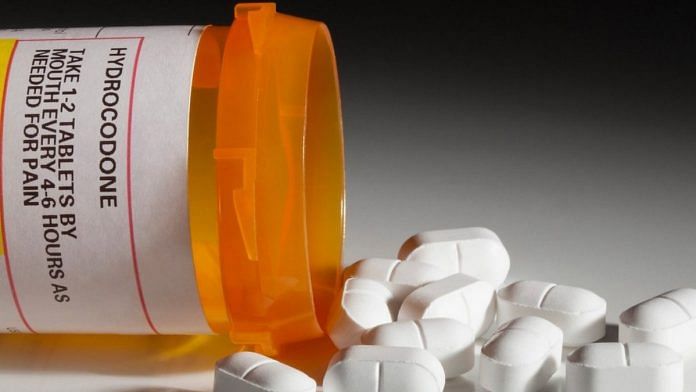New Delhi: The usage of Naloxone, a life-saving drug to reverse the overdose of opioids, is falling in India with fewer patients reporting opium overdose.
According to data with the All India Organisation of Chemists and Druggists (AIOCD), the market size for Naloxone was 30,000 units across the country between July 2014 and July 2015. It has fallen to 15,700 units for the same period in 2018-2019, following a steady drop in the intervening years — the figure was 16,600 units in 2016-17 and 16,100 units in 2017-18.
Naloxone is only sold by two companies in the country — Neon Laboratories and Samarth Lifesciences — and is commonly used at de-addiction centres apart from limited usage at emergency departments or in pain management of cancers and organ transplants.
India has traditionally never had an issue with opioid abuse due to strict regulations, with medical experts saying that much of the abuse came from the prescription of addictive opium-based painkillers such as morphine, methadone, and fentanyl.
Now, the experts say, the availability of new age painkillers, which are devoid of opioids, has considerably reduced the problem. Further, the stringent regulation deters doctors from prescribing opioid-based drugs and pharmaceutical stores from stocking them.
In contrast, opioids — a class of drugs derived from the opium poppy plant — are consumed extensively in the United States for “recreational purposes”, where nearly 48,000 people died of its overdose in 2017. The country has also seen the prescription of Naloxone rise by over 100 per cent between 2017 and 2018 in the United States, according to a report in The Washington Post.
Also read: Modi govt’s flagship drugs scheme has worked well only in five states
Hospitals and chemists shy in procuring opioid medicines
Another reason for the low numbers in India, say medical experts, is the stringent provisions in law. The Narcotic Drugs and Psychotropic Substances (NDPS) Act, 1985, was amended in 2014 to recognise the use of narcotics in pain relief.
The Modi government had then created a separate class of medicines under Schedule X, called the “essential narcotic drugs”, which included six drugs — morphine, fentanyl, methadone, oxycodone, codeine, hydrocodone and tramadol.
But hospitals and chemists are reluctant to procure these drugs as the penalty for any violation is a minimum 10-year prison term.
“These drugs increase the chances of our harassment by government inspectors where even a missing pill can take us to jail for at least 10 years,” said a drug trader and distributor requesting anonymity. “We have stopped procuring these medicines.”
As a result, a number of doctors ThePrint spoke to said that only two to three drugs — morphine, fentanyl and sometimes methadone — are available.
A report by the UK-based publishing house, New Internationalist, states that the use of medicinal morphine in India dropped by a staggering 97 per cent since the introduction of the NDPS Act, 1985.
“Health workers told us that a combination of harsh penalties for minor clerical mistakes and complex bureaucratic regulations prohibited them from applying or maintaining licences to stock morphine due to the burden of paperwork and fear of being penalised for errors,” the report states.
The numbers have further dropped since the 2014 amendment to the law. While most hospitals procure morphine from the government, the private distributor-based supplies have shrunk from 21,300 units between July 2013 and July 2014 to just 1,900 units for the same period in 2018-19. The numbers reflect the distributors and traders supplies to hospitals or government institutions.
Dr A. Zeenat Ahmed, senior consultant, department of internal medicine, Jaypee Hospital, Noida repeated the concern raised by other medical practitioners that “hospitals need to fill up a form before administering morphine or any narcotic-based drug along with the indications and details of the patient so that its relax-usage could be restrained”.
“The usage is very strict and hence, there is no chance of overdosage,” Ahmed said.
New painkillers replacing morphine
Medical experts also said that newer drugs have led to lesser usage of morphine.
“The overdose of morphine was among the top uses for which Naloxone use was encouraged,” said Dr Satish Kaul, internal medicine at Narayana Health, Gurgaon. “But now, morphine is being substituted with lesser addictive and safer drugs such as ketorolac, tramadol and fortwin,” he added.
“With reduced dependence on morphine, we get lesser patients with morphine (opioid) overdose,” said Kaul. “The limited use of morphine is for terminal stage cancer patients or through injections before conducting liver transplants.”
Dr Vishakh Verma, consultant, critical care medicine, at the Dwarka-based Aakash Hospital, said the increased use of drugs such as NMDA and cannabis (bhaang) for ‘recreational purposes’ has also led to the fall in consumption of opioids.
“We receive only one or two cases in a year, where the medicine Naloxone is used by the emergency department. Such overdose cases are either of suicide attempts or people with a known history of drug abuse,” Verma said.
Moreover, according to the medical journal Indian Journal of Palliative Care, Indian doctors are not well-trained in managing pain that has resulted in poor awareness about opioid drugs among the medical fraternity.
Also read: To fix quality of Indian drugs, Modi govt plans to tighten transportation & storage laws



